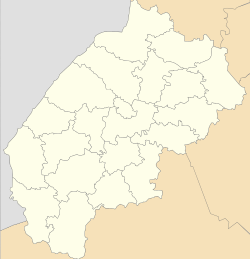Drohobycz
|
Drohobych Дрогóбич |
|||
|---|---|---|---|
| City of regional significance | |||

Drohobych skyline
|
|||
|
|||
| Location of Drohobych | |||
| Coordinates: 49°21′00″N 23°30′00″E / 49.35000°N 23.50000°ECoordinates: 49°21′00″N 23°30′00″E / 49.35000°N 23.50000°E | |||
| Country | Ukraine | ||
| Region | Lviv Oblast | ||
| Municipality | Drohobych | ||
| First mentioned | 1387 | ||
| Government | |||
| • Mayor | Taras Kuchma | ||
| Area | |||
| • Total | 41.0 km2 (15.8 sq mi) | ||
| Population (2016) | |||
| • Total | 76 686 | ||
| Website | http://www.drohobych-rada.gov.ua/ | ||
Drohobych (Ukrainian: Дрогóбич; Polish: Drohobycz; Yiddish: דראָהאָביטש;) is a city of regional significance in Lviv Oblast,Ukraine. It is the administrative center of Drohobych district. In 1939–1941 and 1944–1959 it was the center of Drohobych Oblast.
The city was founded at the end of eleventh century as important transport post between Kyiv Rus' and the rest of Europe. From the fifteenth century the city was developing as a mercantile and saltworks centre. Drohobych became part of Habsburg Empire after the first partition of Poland. In the mid-nineteenth century it became Europe's largest oil extraction center, which significantly contributed to its rapid development. In interwar Poland it was the center of Lviv province county.
The city was the birthplace of well-known personalities like Yuriy Drohobych (Kotermak), Ivan Franko and Bruno Schulz. The city has several oil refineries. The Drohobych saltworks is considered to be the oldest in Europe. The estimated population of the city in 2016 was 76,686.
As the administrative center of the Drohobych Raion (district), Drohobych itself is a city of oblast significance, subordinate directly to the oblast authorities, rather than to the raion administration located in the city itself.
While there are only legendary accounts of it, Drohobych probably existed in the Kievan Rus' period. According to one legend there was a settlement, called Bych, of salt-traders. When Bych was destroyed in the Cumanian raid, the survivors rebuilt the settlement at a nearby location under its current name which means a Second Bych. In the time of Kievan Rus', the Tustan fortress was built near Drohobych. However, scholars view this legend with skepticism, pointing out that Drohobych is a Polish pronunciation of Dorogobuzh, a common East Slavic toponym applied to three different towns in Kievan Rus'.
...
Wikipedia



